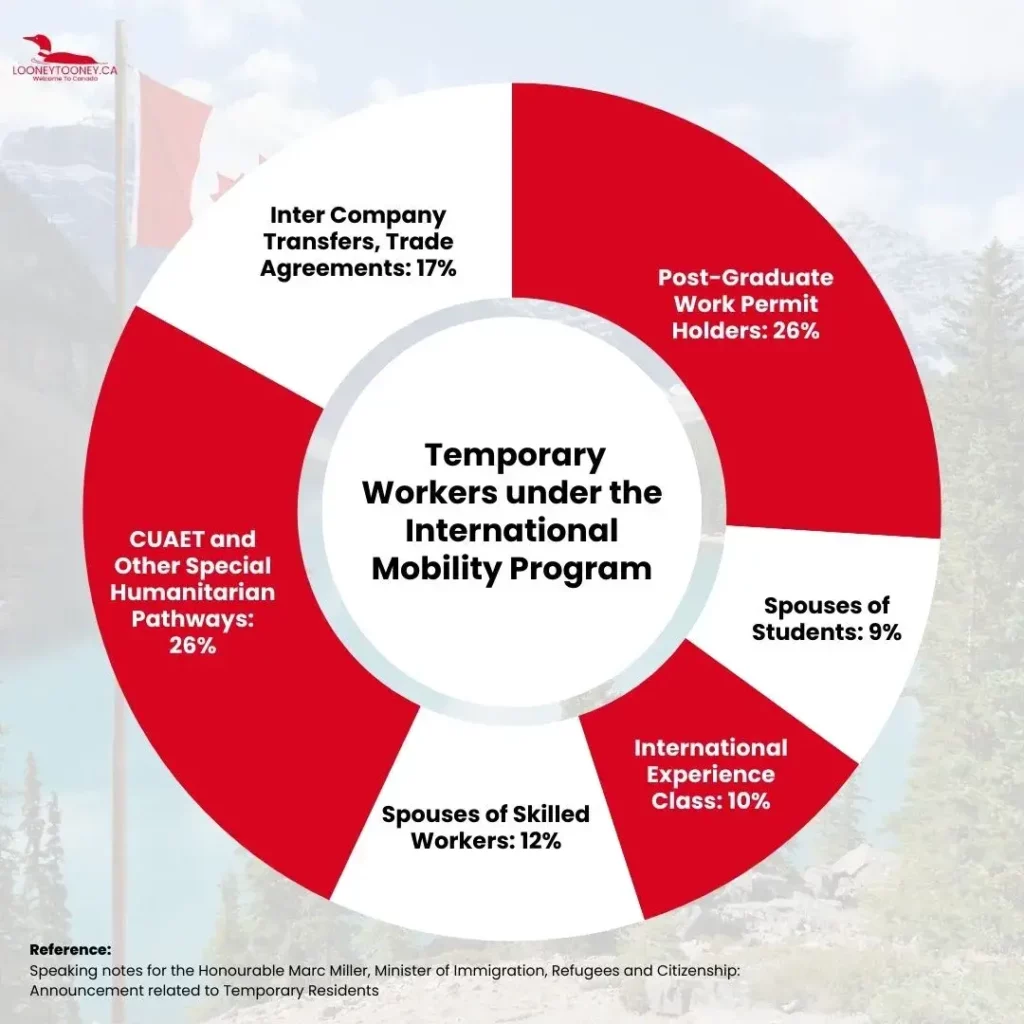The International Mobility Program offers a range of avenues for individuals to work or settle in Canada, promoting cultural exchange, economic growth, and global talent mobility. Under this program, employers can hire or bring in foreign workers without requiring a Labour Market Impact Assessment (LMIA), particularly when there are shared benefits for Canadians and advantageous outcomes for Canada. This article provides comprehensive insights into the IMP, outlining eligibility criteria, application processes for employers and temporary workers, exemptions, and the rights afforded to foreign workers.
Table of Contents
- What is International Mobility Program Canada?
- Categories Eligible for International Mobility Program
- Breakdown of Temporary Workers in International Mobility Program
- How to Apply for a Work Permit? (Only for Temporary Worker)
- Understanding Your Rights When Working in Canada under IMP
- How to Hire a Temporary Foreign Worker? (Only for Employers)
- FAQs on International Mobility Program Canada
What is International Mobility Program Canada?
The International Mobility Program (IMP) allows Canadian employers to hire temporary workers without needing an LMIA. Typically, employers are required to submit an offer of employment via the Employer Portal. Following the employer’s part, the temporary foreign worker will have to apply for a work permit. Upon the arrival of the temporary foreign worker, the employer needs to fulfill specific conditions and responsibilities. Not fulfilling these obligations may lead to penalties for the employer.
This versatile program provides businesses and foreign individuals with various work permit options, enabling them to participate in temporary job opportunities across diverse industries and roles.
Categories Eligible for International Mobility Program
The International Mobility Program includes various categories allowing individuals to work or settle in Canada under specific conditions.
Eligible individuals include:
- International students graduate from Canadian educational institutions.
- Individuals working in Canada temporarily under free trade agreements like NAFTA.
- Individuals taking part in the International Experience Canada program.
- Certain permanent resident applicants settling in Canada while their application is being finalized.
- Spouses of highly skilled foreign workers or students.
Breakdown of Temporary Workers in International Mobility Program
Around 44% of temporary workers in Canada fall under the International Mobility Program. This program includes various categories including individuals with post-graduate work permits, spousal work permits for students or workers, those temporarily visiting Canada under youth mobility agreements, and workers arriving in Canada through intercompany transfers or arrivals through special humanitarian pathways, including those fleeing Ukraine.

The breakdown of this program is as follows:
- Post-Graduate Work Permit holders – 26%
- Spouses of Students – 9%
- Spouses of Skilled Workers 12%
- International Experience Class – 10%
- CUAET and other Humanitarian Pathways 26%
- Inter-company transfers and Trade Agreements – 17%
How to Apply for a Work Permit? (Only for Temporary Worker)
If you apply online outside of Canada
If you apply online from outside Canada, the Federal Government reviews your application to determine if you are eligible to work in Canada. Upon approval, you will receive:
- A port of entry letter of introduction from Immigration, Refugees and Citizenship Canada (IRCC).
- A work permit from a border services officer, if you are still eligible when you arrive in Canada.
If you are eligible to apply for or extend your work permit in Canada
The Federal Government will mail you the work permit if your application is approved. You won’t receive a port of entry letter.
If you qualify to apply at a port of entry
Certain applicants have the option to apply at a port of entry. During this process, the border services officer will assess whether you:
- meet the criteria of the work permit category you are applying for
- are admissible to Canada
If the border services officer is convinced that all criteria are fulfilled, they will issue a work permit.
Understanding Your Rights When Working in Canada under IMP
All workers, including temporary foreign workers, have the same rights and workplace protections as permanent residents and Canadians.
Your employer must:
- Inform you about your rights.
- Provide the signed copy of your employment agreement before you apply for your work permit.
- Pay you for your work according to your employment agreement including any overtime work if specified.
- Ensure a workplace free from abuse like reprisals.
- Adhere to the employment and recruitment guidelines set by the province or territory where you are employed.
- Assist you in accessing healthcare services if you are injured or become ill at work.
Your employer cannot:
- Compel you to perform unsafe work or tasks not specified in your employment agreement.
- Require you to work if you are sick or injured.
- Mandate overtime work if it’s not outlined in your employment agreement.
- Take adverse action against you for reporting mistreatment or unsafe work or for cooperating with a government inspection.
- Confiscate your passport or work permit.
- Alter your immigration status or deport you from Canada.
- Demand repayment of any recruitment fees they may have covered to hire you.
Check rights as a worker in Canada for detailed information.
How to Hire a Temporary Foreign Worker? (Only for Employers)
To hire a temporary worker through the International Mobility Program, employers need to follow these steps:
- Need to pay a $230 employer compliance fee.
- Create and submit an offer of employment form via the Employer Portal. Your offer of employment should include details about your business, temporary worker you intend to hire, job details, wages and other benefits.
To Hire a French-speaking or Bilingual Worker Outside of Quebec
Employers have the option to hire a French-speaking or bilingual worker outside Quebec without requiring an LMIA if the worker:
- Demonstrates moderate proficiency in speaking and listening in French.
- Plans to reside and work outside the province of Quebec.
To Hire an Overnight Camp Counsellor
You have the option to hire an overnight camp counsellor via the IMP. If your prospective worker meets the criteria, obtaining an LMIA is not required. Additionally, depending on the worker’s circumstances, you may qualify for an exemption from the employer compliance fee.
Exemptions
- Open Work Permits: If you hire a temporary worker holding an open work permit, there’s no requirement to submit an offer of employment form or pay the employer compliance fee. An open work permit authorizes the permit holder to work for any employer in Canada.
- Exemptions from Employer Compliance: Certain employers are not obligated to use the Employer Portal or are exempt from paying the compliance fee.
Check if you qualify for Employer compliance exemptions.
Upon submitting an offer of employment via the Employer Portal, you will receive an offer of employment number. This 7-digit number must be provided to the temporary worker you intend to hire or employ.
Once the temporary worker gets this number, they can proceed to fill out a work permit application.
Other Instructions to Tell Your Temporary Worker
Following are the instructions that you need to convey to the temporary worker you hire or employ:
- Ensure that the individual you hire has a valid work permit and complies with the conditions outlined on their work permit.
- Provide the temporary worker with information regarding their rights as a worker in Canada.
- Verify that your temporary worker has the right entry document, such as a Visitor Visa or an Electronic Travel Authorization (eTA), to enter Canada. These documents are typically issued alongside the work permit if arriving Canada from another country.
- Depending on the nature of their work in Canada and their residency history, temporary workers may be required to undergo a medical examination as part of the application process.
- Certain countries may have specific requirements for their citizens departing for employment in Canada. Since temporary workers may need an exit visa or other documents related to their Canadian employment, they should check with their government authorities to determine any prerequisites before departing.
FAQs on International Mobility Program Canada
Check some of the commonly asked questions and their answers related to the International Mobility Program Canada:
Q. What is International Mobility Program?
A. The International Mobility Program Canada allows employers to hire temporary workers without requiring an LMIA. Employers must submit an employment offer via the Employer Portal; following this, the temporary foreign worker must apply for a work permit.
Q. Who is eligible for the International Mobility Program?
A. Eligible individuals include international students, workers under free trade agreements like NAFTA, participants in the International Experience Canada program, certain permanent resident applicants, and spouses of highly skilled foreign workers.
Q. Does IMP require LMIA?
A. No, the International Mobility Program does not require a Labour Market Impact Assessment.
Q. What rights do temporary foreign workers have under the IMP?
A. Temporary foreign workers have the same workplace protections as Canadians, including rights to a safe workplace, fair pay, and healthcare access. Employers cannot compel unsafe work or retaliate against workers for reporting issues.
Take a look at these additional articles:
- Temporary Resident Permit
- Canada Visitor Visa
- Intra-Company Transfer Canada
- Bridging Open Work Permit Canada
- Spouse Open Work Permit Canada
For more information, stay tuned to LooneyTooney.ca. By staying connected, you will get valuable insights and stay updated on the latest developments.





